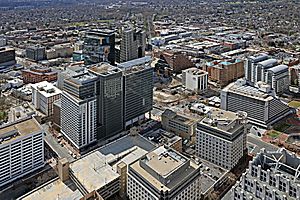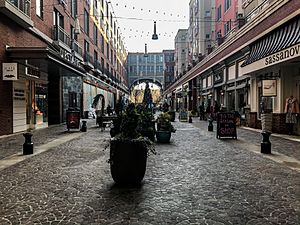Bethesda, Maryland facts for kids
Quick facts for kids
Bethesda, Maryland
|
|
|---|---|
| Bethesda Urban Partnership, Inc. | |
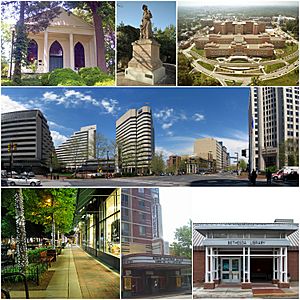
From top: Bethesda Meeting House, Bethesda's Madonna of the Trail statue, the National Institutes of Health, downtown Bethesda near the Bethesda Metro station, Bethesda Avenue at night, Bethesda Theatre, and the Connie Morella Library.
|
|
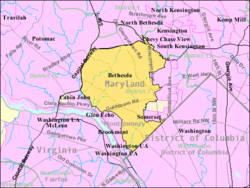
Boundaries of Bethesda CDP from U.S. Census Bureau
|
|
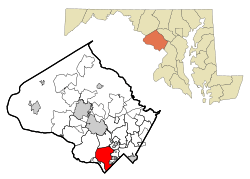
Location of Bethesda in Montgomery County, Maryland
|
|
| Country | |
| State | |
| County | |
| Government | |
| • Type | Management organization with county sanction |
| Area | |
| • Total | 13.33 sq mi (34.52 km2) |
| • Land | 13.26 sq mi (34.35 km2) |
| • Water | 0.07 sq mi (0.17 km2) |
| Elevation | 354 ft (108 m) |
| Population
(2020)
|
|
| • Total | 68,056 |
| • Density | 5,131.65/sq mi (1,981.30/km2) |
| Time zone | UTC−5 (Eastern (EST)) |
| • Summer (DST) | UTC−4 (EDT) |
| ZIP Codes |
20800–20899
|
| Area codes | 301, 240 |
| FIPS code | 24-07125 |
| GNIS feature ID | 2389206 |
Bethesda (pronounced bə-THƐZ-də) is a community in southern Montgomery County, Maryland, United States. It's located just northwest of Washington, D.C.. Bethesda is a major center for businesses and government offices in the Washington area. It's also a national hub for medical research. In 2020, about 68,056 people lived there.
Contents
What's in a Name?
Bethesda gets its name from a local church, the Bethesda Meeting House. This church was built in 1820 and rebuilt in 1849. The church itself was named after the Pool of Bethesda in Jerusalem.
A Look Back in Time
Early Days
Long ago, the land where Bethesda now stands was home to Native American tribes like the Piscataway and Nacotchtank. The first European to visit the area was a fur trader named Henry Fleet in the 1620s. He sailed up the Potomac River and spent time with the Piscataway tribe.
Later, Henry Darnall surveyed a large area of land in 1694. This became the first land grant in Bethesda. For most of the 1700s, people in Bethesda mainly farmed tobacco. During the American Revolutionary War, Bethesda helped by supplying the new American navy.
Growing into a Town
Between 1805 and 1821, Bethesda became a stop along the Washington and Rockville Turnpike. This road was used to transport tobacco and other goods. The Bethesda Meeting House, a Presbyterian church, was built in 1820. After it burned down in 1849, it was rebuilt nearby.
In 1852, a post office was opened in the area. By 1862, a small community had formed around a store and tollhouse. This place was known as "Darcy's Store." It had a blacksmith shop, a church, a school, and a few homes. In 1871, the postmaster renamed the settlement "Bethesda" after the church.
Modern Growth
In the early 1900s, Bethesda started to grow much faster. This was partly because a streetcar line was built in 1890. A railroad line, the Georgetown Branch, also helped connect Bethesda to other towns. This old railroad line is now a popular walking and biking path called the Capital Crescent Trail. It's used by over a million people each year!
Wealthy families built large mansions along Rockville Pike. Some of these old estates are now schools or parts of important medical campuses. For example, the "Winona" manor house became part of the National Institutes of Health (NIH) campus.
After World War II, Bethesda grew even more quickly. Big medical centers like the National Naval Medical Center (now part of Walter Reed) and the NIH were built here. This brought many government workers, doctors, and businesses to the area.
In 1984, the Washington Metro subway system expanded to Bethesda. This made it much easier to travel to and from Washington, D.C. It also led to the building of many new offices and homes around the Bethesda Metro station.
Where is Bethesda?

Bethesda covers about 13.2 square miles (34.2 square kilometers). Most of it is land, with a small amount of water. The main road through Bethesda is Maryland Route 355. This road connects Bethesda to other communities like Rockville to the north and Washington, D.C. to the south.
Downtown Bethesda is located where Wisconsin Avenue, Old Georgetown Road, and East-West Highway meet. This spot is only about two and a half miles from Washington, D.C. Other important parts of downtown Bethesda include the Woodmont Triangle and Bethesda Row. The Bethesda Metro station is also in the heart of downtown. Another Metro stop, Medical Center, serves the NIH campus and the Walter Reed National Military Medical Center.
People of Bethesda
Bethesda is known for being a very well-educated area. In 2000, it was named the best-educated city in the U.S. for places with 50,000 or more people. About 79% of adults aged 25 or older have a bachelor's degree. Many people who live in Bethesda work in Washington, D.C.
In 2020, the population of Bethesda was about 68,056. Most residents were non-Hispanic white (69.5%). Other groups included Hispanic or Latino (8.9%), Black (4.9%), and Asian (11.7%). About 24.4% of the people in Bethesda were born outside the U.S.
Important Places

Bethesda is home to several important medical institutions. These include the National Institutes of Health (NIH) and the Walter Reed National Military Medical Center. These places are leaders in medical research and care.
Many large companies have their main offices in Bethesda. These include the defense company Lockheed Martin and the hotel chain Marriott International. The Discovery Channel used to have its headquarters here too. You can also find many banks, investment firms, and law offices in Bethesda.
For sports fans, Bethesda is home to the Congressional Country Club. This famous golf club has hosted major golf tournaments, including the U.S. Open. Bethesda also has the Bethesda Big Train, a summer baseball team for college players.
Several countries have their ambassador's homes in Bethesda. This shows how important the area is.
In downtown Bethesda, you can see one of the Madonna of the Trail monuments. This statue honors the courage of pioneer women. The Capital Crescent Trail also starts here, following old railroad tracks. The Walter Reed Medical Center and the Bethesda Theater are examples of beautiful Art Deco buildings in the area.
Bethesda Row
Bethesda Row is a popular area in downtown Bethesda. It has a mix of apartments, shops, restaurants, offices, and entertainment. It's designed to be a lively place where people can live, work, and have fun. You can find stores like the Apple Store and many places to eat there.
Learning in Bethesda
Bethesda is part of the Montgomery County Public School District.
Public Schools
- Elementary Schools: Ashburton, Bannockburn, Bethesda, Bradley Hills, Burning Tree, Carderock Springs, Seven Locks, Westbrook, Wood Acres, Wyngate.
- Middle Schools: North Bethesda, Thomas W. Pyle, Westland.
- High Schools: Bethesda-Chevy Chase, Walt Whitman, Walter Johnson.
Private Schools
Bethesda also has many private schools, including:
- Bethesda Community School
- Feynman School
- Rochambeau French International School
- Georgetown Preparatory School
- The Harbor School
- Holton-Arms
- Landon
- Little Flower School
- Mater Dei School
- Norwood
- Oneness-Family School
- Our Lady of Lourdes School
- St. Andrew's Episcopal School
- St. Bartholomew
- Saint Jane de Chantal Catholic School
- Sidwell Friends School (Lower School)
- Stone Ridge School of the Sacred Heart
- Washington Episcopal School
- Washington Waldorf School
- The Woods Academy
Universities
The Uniformed Services University of the Health Sciences (USU) is in Bethesda. It's a special university that trains doctors and nurses for the U.S. military and public health service. The National Intelligence University is also located here.
The Washington Japanese Language School, which helps Japanese-speaking children learn their language, holds classes at the Stone Ridge School.
Businesses in Bethesda
Bethesda is home to many well-known companies:
- AdvisorShares
- AREVA (U.S. headquarters)
- ASCII Group
- Calvert Investments
- Cambridge Information Group
- Clark Construction
- Coventry Health Care
- Cystic Fibrosis Foundation
- Enviva
- Fox Television Stations (WTTG and WDCA)
- HMSHost
- Host Hotels & Resorts
- International Neuroethics Society
- JBG Smith
- Lockheed Martin
- Marriott International
- NBC Sports Washington
- ProShares
- Ritz Carlton
- RLJ Companies
- United States Enrichment Corporation
- Youth For Understanding USA
- Wellness Corporate Solutions
How Bethesda is Managed
Downtown Bethesda is managed by the Bethesda Urban Partnership. This is a non-profit group created in 1994 by Montgomery County to help run and improve the downtown area.
Getting Around Bethesda
Public Transit
The Washington Metro subway system has two stops in Bethesda on its Red Line: the Bethesda station in downtown and the Medical Center station near the hospitals.
A new light rail line, the Purple Line, is being built. It will connect Bethesda directly to places like Silver Spring and the University of Maryland. This will make it easier to travel across the region without going through central Washington, D.C.
Buses
- The WMATA Metrobus system serves Bethesda.
- The Montgomery County Ride On bus system has several routes here.
- The Bethesda Circulator is a free bus that runs a loop around downtown Bethesda, Monday through Saturday.
Long-Distance Buses
You can also find long-distance bus services from Bethesda. For example, Vamoose Bus and Tripper Bus offer rides from downtown Bethesda to New York City.
Famous People from Bethesda
Many well-known people have lived in Bethesda, including:
- Jonathan Allen, journalist
- José Andrés, chef
- Trace Armstrong, former NFL player
- Red Auerbach, former NBA coach
- Devlin Barnes, soccer player
- Aran Bell, ballet dancer
- Deane Beman, PGA Tour Commissioner
- Ezra Taft Benson, former U.S. Secretary of Agriculture
- Wolf Blitzer, journalist
- Mike Brey, basketball coach
- James Brown, sportscaster
- Preston Burpo, former MLS player
- Patrick Byrne, entrepreneur
- Andrea Carroll, soprano
- Michael Cerveris, actor
- Connie Chung, television journalist
- Colin Cloherty, NFL player
- Steve Coll, journalist and author
- Candy Crowley, journalist
- E. J. Dionne, journalist
- David Dobkin, director
- Michael Dunn, NFL player
- William Eacho, former U.S. ambassador
- Gregg Easterbrook, sports columnist
- Jo Ann Emerson, former U.S. Representative
- Kenneth Feinberg, attorney
- John Feinstein, author
- Janet Foutty, businessperson
- Thomas Frank, journalist
- Neal Fredericks, cinematographer
- Thomas Friedman, journalist
- Merrick Garland, U.S. Attorney General
- Carol Guess, poet
- Howard Gutman, former U.S. ambassador
- Mark Halperin, journalist
- Steve Handelsman, journalist
- Laura Hillenbrand, author
- Henry Hodges, actor
- Antawn Jamison, basketball player
- Walter Johnson, baseball player
- Spike Jonze, director
- Larry Kaufman, chess Grandmaster
- Brett Kavanaugh, U.S. Supreme Court Justice
- Judith Kent, business executive
- Julie Kent, ballet dancer
- Greg Koch, former NFL player
- Ferenc Körmendi, Hungarian novelist
- Judy Kuhn, actress
- Tim Kurkjian, ESPN analyst
- Katie Ledecky, Olympic champion swimmer
- Nils Lofgren, musician
- Julia Louis-Dreyfus, actress
- Allison Macfarlane, former Nuclear Regulatory Commission chair
- Justin Maxwell, MLB player
- Matt McCoy, actor
- Alice McDermott, author
- Sean Murray, actor
- Alondra Nelson, sociologist
- Martin O'Malley, former governor of Maryland
- Reza Pahlavi, Iranian royalty
- Nick Palatas, actor
- Periphery, progressive metal band
- Maury Povich, television host
- Mark Pryor, former U.S. Senator
- Giuliana Rancic, celebrity news personality
- Patricia Richardson, actress
- James Risen, journalist
- Alexandra Robbins, author
- Cokie Roberts, journalist
- Wayne Rooney, British soccer player
- Richard Schiff, actor
- Dan Shanoff, sports columnist
- David Simon, author and producer
- Gordon Smith, former U.S. Senator
- Daniel Stern, actor
- John J. Sweeney, former President of the AFL-CIO
- Jacob Tamarkin, mathematician
- George Spiro Thanos, martial artist
- Jeff Tremaine, director
- Christopher Weaver, software developer
- Meredith Whitney, businesswoman
- Thomas Wieser, economist
- Michael Wilbon, journalist
- Gedion Zelalem, professional footballer
See also
 In Spanish: Bethesda (Maryland) para niños
In Spanish: Bethesda (Maryland) para niños


